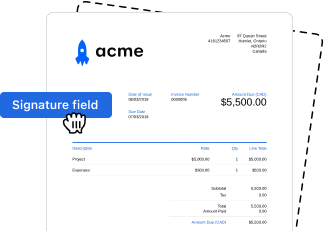Change Email Signature in Outreach with airSlate SignNow
- Quick to start
- Easy-to-use
- 24/7 support
Simplified document journeys for small teams and individuals




We spread the word about digital transformation
Why choose airSlate SignNow
-
Free 7-day trial. Choose the plan you need and try it risk-free.
-
Honest pricing for full-featured plans. airSlate SignNow offers subscription plans with no overages or hidden fees at renewal.
-
Enterprise-grade security. airSlate SignNow helps you comply with global security standards.







Your complete how-to guide - change email signature in outreach
Change Email Signature in OutsignNow
In this How-To guide, we will walk you through the steps to change your email signature in OutsignNow. This can help you customize your email communications and make a lasting impression on your recipients.
Steps to Change Email Signature in OutsignNow:
- Launch your OutsignNow account in your web browser.
- Go to the settings section where you can update your email signature.
- Edit your email signature with your desired information and formatting preferences.
- Save the changes to apply your new email signature across all your outgoing emails.
By following these simple steps, you can easily update your email signature in OutsignNow and enhance your email communication with a personal touch. Make sure to review and test your new signature before sending out any emails.
For more tips and tricks on email outsignNow and communication, visit our website today!
How it works
Rate your experience
What is the process for changing your email signature in airSlate SignNow?
Changing your email signature in airSlate SignNow is a straightforward process that allows you to customize how your name and contact information appear in emails sent from the platform. This feature is essential for maintaining a professional appearance in your communications. The email signature can include your name, title, company name, and any other relevant details you wish to share with recipients.
Steps to change your email signature in airSlate SignNow
To change your email signature in airSlate SignNow, follow these steps:
- Log in to your airSlate SignNow account.
- Navigate to your account settings, usually found in the profile section.
- Locate the email signature option within the settings menu.
- Enter your desired signature in the text box provided. You can format the text as needed.
- Save your changes to ensure the new signature is applied to future emails.
After completing these steps, your updated email signature will automatically appear in all outgoing emails sent through airSlate SignNow, ensuring consistency and professionalism in your digital communications.
Legal considerations for email signatures in airSlate SignNow
When using an email signature in airSlate SignNow, it is important to consider the legal implications. An email signature can serve as a form of identification and may be used to validate the authenticity of the communication. Ensure that your signature complies with relevant regulations, such as including necessary disclaimers or confidentiality notices, particularly if you are dealing with sensitive information.
Best practices for creating an effective email signature
To create an effective email signature in airSlate SignNow, consider the following best practices:
- Keep it concise: Limit the information to essential details to avoid clutter.
- Use professional language: Ensure that the tone matches your business environment.
- Include contact information: Provide multiple ways for recipients to reach you, such as phone and email.
- Add social media links: If relevant, include links to professional social media profiles.
- Test the signature: Send a test email to verify that the signature appears correctly across different email clients.
Implementing these best practices will enhance your email signature's effectiveness and ensure it reflects your professionalism.
Security and compliance guidelines for email signatures
When using email signatures in airSlate SignNow, it is crucial to adhere to security and compliance guidelines. Ensure that your signature does not contain sensitive information that could be misused if intercepted. Additionally, be aware of any industry-specific regulations regarding email communications, such as HIPAA for healthcare or GDPR for data protection, to ensure compliance with legal standards.
Common issues when changing email signatures and how to resolve them
Users may encounter several common issues when changing their email signatures in airSlate SignNow. These can include:
- Changes not saving: Ensure you click the save button after making edits.
- Formatting issues: Use the formatting tools provided to ensure your signature appears as intended.
- Signature not appearing in emails: Check your email settings to confirm that the signature feature is enabled.
If you experience any difficulties, reviewing the help section or contacting airSlate SignNow support can provide additional assistance.
-
Best ROI. Our customers achieve an average 7x ROI within the first six months.
-
Scales with your use cases. From SMBs to mid-market, airSlate SignNow delivers results for businesses of all sizes.
-
Intuitive UI and API. Sign and send documents from your apps in minutes.
FAQs
-
How do I change my email signature in airSlate SignNow?
To change your email signature in airSlate SignNow, navigate to your account settings. Look for the 'Email Signature' section, where you can edit your current signature. After making your changes, be sure to save them to ensure your new signature is applied to all outgoing emails.
-
What features does airSlate SignNow offer for email signatures?
airSlate SignNow provides customizable email signatures that allow you to include your name, title, and contact information. You can also add logos and social media links to enhance your professional appearance. This feature is particularly useful for maintaining brand consistency in your communications.
-
Is there a cost associated with changing my email signature in airSlate SignNow?
Changing your email signature in airSlate SignNow is included in your subscription plan at no additional cost. Whether you are on a basic or premium plan, you can easily update your signature without incurring extra fees. This makes it a cost-effective solution for businesses looking to maintain a professional image.
-
Can I integrate my email signature with other tools in airSlate SignNow?
Yes, airSlate SignNow allows you to integrate your email signature with various tools and applications. This integration helps streamline your workflow and ensures that your signature is consistently applied across different platforms. You can easily manage these integrations from your account settings.
-
What are the benefits of using a customized email signature in airSlate SignNow?
Using a customized email signature in airSlate SignNow enhances your professional image and promotes brand recognition. It allows you to provide essential contact information and links to your website or social media. This can lead to increased engagement and better communication with your clients.
-
Can I have different email signatures for different purposes in airSlate SignNow?
Absolutely! airSlate SignNow allows you to create multiple email signatures for different purposes. Whether you need a formal signature for client communications or a more casual one for internal emails, you can easily switch between them in your account settings.
-
How often can I change my email signature in airSlate SignNow?
You can change your email signature in airSlate SignNow as often as you like. There are no restrictions on how frequently you can update your signature, allowing you to keep it current with any changes in your contact information or branding. Simply go to your account settings to make updates.
Related searches to change email signature in outreach
Join over 28 million airSlate SignNow users
Get more for change email signature in outreach
- Understanding e-signature disclaimer for seamless ...
- Discover how to perform a digital signature check ...
- Effortlessly create a digital sign in Excel spreadsheet
- Seamless documentation for e-signing made simple
- Easily digital sign real estate contracts for a ...
- Simplify your agreements with a digital signature ...
- Master your digital signature manual with airSlate ...




























